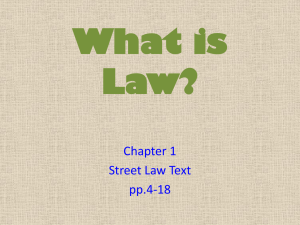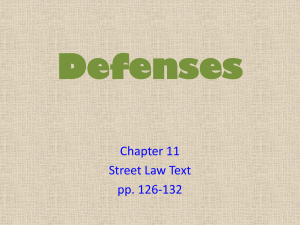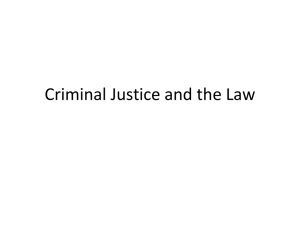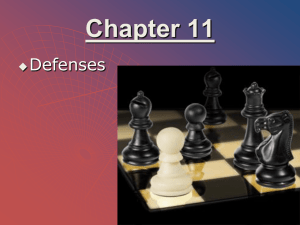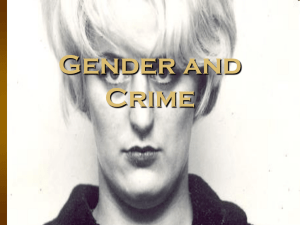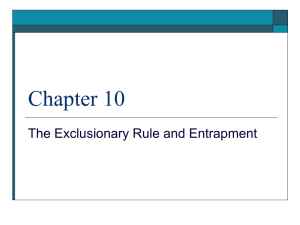Chapter 11: Defenses - Capital High School
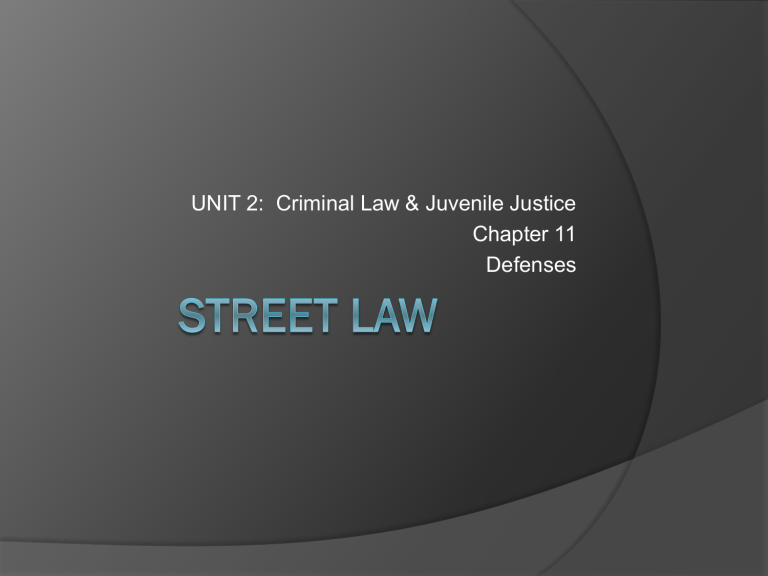
UNIT 2: Criminal Law & Juvenile Justice
Chapter 11
Defenses
For a conviction to occur in a criminal case, two requirements must be met
The prosecutor must establish beyond a reasonable doubt that the defendant committed the act in question
and that the defendant committed the act with the required intent
The defendant does not have to present a defense
He or she can simply force the government
(the prosecutor) to prove its case
However, several defenses are available to defendants in criminal cases
For example, sometimes a criminal act may be considered excusable or justifiable
○ Defenses in this category include self-defense, defense of property, & defense of others
O.J. Simpson Case
One of the most publicized criminal cases in recent years was the murder trial of former football star O.J. Simpson, in which he claimed he wasn’t guilty in the killings of his ex-wife & her friend
By focusing the defense on improper police behavior & investigation techniques, his legal team convinced a jury there was reasonable doubt as to his guilt
He was found not guilty on all counts
In a civil case for wrongful death brought by the surviving family members, a jury found that a preponderance of the evidence went against Simpson
He was found liable & ordered to pay compensatory & punitive damages to the families of the two victims
The idea behind the two different standards is that the penalty in criminal cases is much more serious
criminal record,
imprisonment, &
possible death sentence
Criminal penalties involve infringement on an individual’s liberty (and possibly life) in contrast to the lesser penalty in civil cases, which is usually only monetary damages
DEFENSE DEFINITIONS
Handout: Ch. 11 – Basic Concepts
Alibi evidence that the defendant was elsewhere at the time of the crime
Defense of Others
Right to use reasonable force to defend other people
Defense of Property
Right to use reasonable force to defend property
Duress
Acting as a result of coercion or a threat of immediate danger to life or personal safety
Elements of the crime were not all present
One of the required elements (identified in the
RCW’s) of the crime is missing
Entrapment
Evidence that defendant would not have committed the crime if not for the inducement of a police officer
Infancy
Children under certain ages are incapable of committing a crime
Intoxication being under the influence of drugs or alcohol to the extent that the defendant could not form the specific intent to commit the crime; applicable only in specific intent crimes
Insanity
Due to a mental illness or defect, defendants did not know what they were doing or did not know the difference between right and wrong.
In other states, defendants lacked substantial capacity to appreciate the nature of the crime or to confirm their conduct to the requirements of the law
Lack of Criminal Intent
Guilty mind required for the crime is missing
Mistake in Identity
Defendant was incorrectly identified as the perpetrator
Necessity
The defendant is compelled to react to an unavoidable situation in order to protect life
Self-Defense
Reasonable amount of force to protect oneself
DEFENSE CATEGORIES:
No crime has been committed
Defendant did not commit the crime
Defendant committed a criminal act, but the act was excusable or justifiable
Defendant committed a criminal act but is not criminally responsible for his or her actions
Fill out bottom of Basic Concepts Handout
No Crime Has Been Committed
The defendant may decide to try to prove that
(1) no crime was committed, or
(2) there was no criminal intent because the act was simply committed by mistake
Answers:
#5 – Elements of the crime were not all present
#10 – Lack of criminal intent
Defendant Did Not
Commit the Crime
When there is confusion or doubt about who committed a crime, the defendant may try to prove that there has been a case of mistaken identity & that he or she was not the person responsible for the crime
Today, DNA testing can sometimes be used to prove whether or not the defendant was responsible
In recent years, some people convicted of crimes have been able to prove their innocence because of this testing
Answers:
#1 – Alibi
#11
– Mistake in identity
Defendant Committed a Criminal Act, but the Act Was Excusable or Justifiable
Sometimes a criminal act may be considered excusable or justifiable
This type of defense includes (13) selfdefense & defense of (3) property & (2) others
The law allows people to use deadly force when their own or someone else's life is in danger
The law also permits people to use reasonable force to protect themselves, their property, & others from harm
Bernhard Goetz—Self-Defense
One famous case of self-defense involved a man named Bernhard Goetz, who shot four teens in what he claimed was self-defense while riding on a New York City subway train
Goetz had been mugged & robbed of electronic equipment on a subway train a few years earlier
He feared it would happen again, especially in his neighborhood, which was frequented by drug addicts & other criminals
Therefore, Goetz applied for a license to carry a gun to protect himself
He was denied permission but obtained a gun anyway
One day he was surrounded in a subway car by four youths who first asked him for “the time,” then “a match,” & then “five dollars to play video games”
Goetz replied, “I’ll give you each five dollars,”
& pulled a .38 revolver from his pocket & shot all four youths
Evidence showed that he shot one in the back as he lay on the floor
Goetz ran from the train & escaped but was later arrested
All four youths were seriously hurt & one was permanently paralyzed
Three carried sharpened screwdrivers in their pockets at the time of the shooting that they may have used to pry open video game machines to obtain quarters
If Goetz were tried for assault, what would he have to establish to prove selfdefense?
Based on the facts, do you believe this was a case of self-defense?
Should the teenagers be charged?
If so, with what crime?
Should citizens be allowed to carry guns
& use them in self-defense?
Was Goetz guilty of a crime?
If so, what crime?
If convicted, what penalties, if any, do you think he should face?
Goetz was eventually acquitted for attempted murder & assault
He was found guilty of illegal possession of a deadly weapon & reckless endangerment, & spent time in prison
Defendant Committed a Criminal Act but Is Not Criminally Responsible for
His or Her Actions
In this type of defense, the defendant acknowledges that he or she committed the act but argues that there are reasons the law should not consider the defendant criminally responsible
The law recognizes several reasons that may excuse a defendant from criminal responsibility
These defenses include (7) infancy, (8) intoxication, (9) insanity, (6) entrapment, (4) duress, & (12) necessity
Infancy Defense
The idea behind the infancy defense is similar to the insanity defense:
People should not be convicted or punished if they do not know right from wrong
If a three-year old child plays with matches, starts a fire, & the house burns down, is it arson?
What if the child were eight years old?
Eleven years old?
Sixteen years old?
Would your answers differ if kids of the same age were fighting & one shot the other?
Intoxication
Defendants claim that at the time of the crime they were so drunk or high on drugs that they did not know what they were doing
Voluntary intoxication is not a defense to a crime
However, it may be a valid defense if the crime requires proof of a specific mental state
Example:
Grady is charged with assault with intent to kill
He claims he was drunk
If he can prove that he was so drunk that he could not have formed the intent to kill, his intoxication might be a valid defense
Grady can still be convicted of the crime of assault, because specific intent is not required to prove that crime
However, if Grady had decided to kill the victim before he got drunk or if he got drunk to get up enough nerve to commit the crime, the intoxication would not be a defense
This is because the required mental state (the intent to kill) existed before the drunkenness
Insanity Defense
The basic concept is that people who have a mental disease or disorder should not be convicted if they do not know what they are doing or if they do not know the difference between right & wrong
There is a difference between not guilty by reason of insanity (used by most states & the federal government) & not competent to stand trial that exists in some states
The accused’s mental state can be an issue in determining whether
The defendant is competent to stand trial
The defendant was sane at the time of the criminal act, &
The defendant is sane after the trial
The insanity defense applies only if the accused was insane at the time of the crime
How & when may a state determine that person found not guilty by reason of insanity should reenter society?
Who should make that decision?

